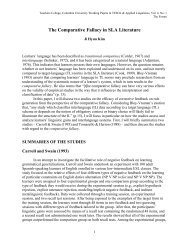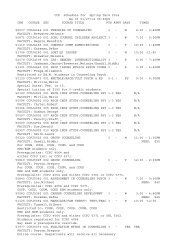4th Grade, Class A Science Lesson Plan November 14, 2000 ...
4th Grade, Class A Science Lesson Plan November 14, 2000 ...
4th Grade, Class A Science Lesson Plan November 14, 2000 ...
You also want an ePaper? Increase the reach of your titles
YUMPU automatically turns print PDFs into web optimized ePapers that Google loves.
4 th <strong>Grade</strong>, <strong>Class</strong> A <strong>Science</strong> <strong>Lesson</strong> <strong>Plan</strong><br />
<strong>November</strong> <strong>14</strong>, <strong>2000</strong> (Tuesday)<br />
2nd Period <strong>Science</strong> Lab. #1<br />
Instructor: Isao Hirano<br />
Number of Students: 20<br />
1. Name of the Unit: Behavior of Substances at Different Temperatures<br />
2. Relationship of the Unit to the Curriculum<br />
Previously Learned<br />
Concepts<br />
3 rd <strong>Grade</strong><br />
Examining air and water<br />
Air and water in<br />
enclosed space<br />
Creating objects that<br />
use the nature of air or<br />
water<br />
Behavior of Substances at<br />
Different Temperatures<br />
Volume and temperature of<br />
air, water, and metal<br />
How air, water, and metal<br />
heat up<br />
Water in nature (1)<br />
Changes in the water<br />
Water in nature (2)<br />
Evaporation and boiling<br />
The three states of water<br />
(solid, liquid, gas)<br />
3. Instructional <strong>Plan</strong><br />
Behavior of Substances at Different Temperatures (Total: 12 lessons)<br />
Volume of air at different temperatures 2 lessons<br />
Volume of water at different temperatures 2 lessons<br />
Volume of metal at different temperatures 2 lessons<br />
How materials heat up 5 lessons<br />
How metal and water heat up<br />
How metal heats up<br />
How water heats up <br />
How water heats up (this lesson)<br />
How air heats up<br />
Conclusion 1 lesson<br />
Concepts to be Learned in the<br />
Future<br />
5 th <strong>Grade</strong><br />
How materials dissolve<br />
Differences in how<br />
materials dissolve in<br />
water based on differences<br />
in temperature and<br />
quantity<br />
How to take out the<br />
dissolved material<br />
6 th <strong>Grade</strong><br />
How materials burn in air.<br />
Burning of plant material;<br />
oxygen/carbon dioxide<br />
Characteristics of solutions<br />
Metal in solutions<br />
Acid, neutral, and alkaline<br />
solutions<br />
Solutions of dissolved<br />
gases<br />
4. Instruction of this <strong>Lesson</strong><br />
(1) Title: How Water Heats Up <br />
(2) Goal <br />
Be able to verify the students’ initial prediction of how water will heat up through<br />
experimentation.<br />
© <strong>2000</strong>, Greenwich Japanese School & <strong>Lesson</strong> Study Research Group Page 1
Be able to investigate how water heats up, and to notice that the heated water is moving.<br />
Be able to think about the differences between how metal and water heat up.<br />
(3) Relationship of the <strong>Lesson</strong> to the Goal of <strong>Science</strong> Education at the School<br />
<strong>Science</strong> Education Goal:<br />
“Not only to rear students’ minds to autonomously connect with surrounding nature<br />
and to love nature, but also to foster ability to investigate problems in nature<br />
scientifically.”<br />
There are many students who have had the experience of heating up something through<br />
cooking in everyday life. However, I think many of them have not thought out the<br />
relationship between material and temperature. Therefore, the During the first half of this<br />
unit, students learned about the volume change in air, water, and metal that are associated<br />
wit changing temperature, and learned that the changes are different among these three<br />
materials. During the second half of this unit, the students will learn how different<br />
materials heat up differently.<br />
My students have been experiencing many activities that are oriented toward identifying<br />
problems autonomously, establishing hypotheses, and testing them by developing their own<br />
experimental methods. I believe that students can develop problem-solving abilities through<br />
these activities.<br />
Last week, my students studied how metal, that they find in their surroundings, heats up.<br />
In this lesson, the students will investigate objectively how water heats up by thinking out<br />
their own experimental methods. Then they will compare their findings with their findings<br />
with metal. I like to make the most of students’ ideas, and support them, in order for them<br />
to be able to solve the problem on their own.<br />
© <strong>2000</strong>, Greenwich Japanese School & <strong>Lesson</strong> Study Research Group Page 2
(4) Learning Process (How water heats up : a lesson before this lesson)<br />
Steps<br />
(min.)<br />
Introduction<br />
(5)<br />
<br />
Activity of the Students<br />
Teacher’s Support and<br />
Points to Remember<br />
Recalling what they did previously Ask the students to recall their<br />
experiment during the previous<br />
When we warmed up water in a lesson and encourage their<br />
test tube, it was warm at the<br />
interest in further investigation.<br />
upper part of it. Why it was<br />
like that?<br />
Grasping the problem<br />
Let’s investigate in detail how the water heats up!<br />
Evaluation<br />
View Point<br />
Were the<br />
students able to<br />
recall what they<br />
learned<br />
previously?<br />
Development<br />
35<br />
Predictions about the problem<br />
Predicting it individually<br />
Write down their predictin on<br />
their worksheets<br />
<br />
Anticipated students’ reaction:<br />
<br />
Just like the metal, it will<br />
heat up first closest to the<br />
fire.<br />
Ask students to predict how the<br />
water will heat up by asking<br />
them to recall the experiment of<br />
heating up water in a test tube.<br />
I wonder if the heated water<br />
will move upward?<br />
Prepare a worksheet that helps<br />
students express their ideas in<br />
words and pictures.<br />
Were the<br />
students able to<br />
propose their own<br />
ideas about the<br />
problem?<br />
Discussing as a group how to solve<br />
the problem<br />
Anticipated students’ ideas<br />
What would happen if we put<br />
something light in the water<br />
and then heat it up?<br />
What would happen if<br />
we put in some honey?<br />
Make sure to allocate enough<br />
time for this section in order for<br />
the students to propose many<br />
ideas.<br />
Prepare experimental tools and<br />
worksheets so that the students<br />
can design experimental devices<br />
based on their individual ideas.<br />
It might be useful if we had<br />
water that changes its color<br />
according to its temperature.<br />
Were the<br />
students able to<br />
think of ways to<br />
solving the<br />
problem?<br />
Were the<br />
students able to<br />
design<br />
experimental<br />
devices for use in<br />
the next lesson?<br />
Conclusion<br />
5<br />
Each group presents their idea for<br />
how to actually conduct the<br />
experiment during the next lesson.<br />
Help them to clarify what they<br />
are going to use for what<br />
purpose.<br />
Were the<br />
students able to<br />
present their<br />
ideas for the<br />
experiment that<br />
will be<br />
conducting<br />
during the next<br />
lesson clearly?<br />
© <strong>2000</strong>, Greenwich Japanese School & <strong>Lesson</strong> Study Research Group Page 3
(5) Learning Process (this lesson: How water heats up )<br />
Steps<br />
(min.)<br />
Introduction<br />
(5)<br />
<br />
Development<br />
#1<br />
(20)<br />
Activity of the Students<br />
Grasping the problem<br />
Let’s investigate in detail how the water heats up!<br />
Confirming the experimental<br />
procedure of their own group<br />
Investigating how water heats up<br />
according to the experimental plan<br />
that each group made<br />
Experiment Example #1<br />
One method involves<br />
mixing some sawdust or<br />
miso (soybean paste) into<br />
the water and observe what<br />
happens when it heats up.<br />
Teacher’s Support and<br />
Points to Remember<br />
Ask the students to describe<br />
the purpose of the<br />
experiment and the<br />
procedure.<br />
Make 5 groups of 4 students<br />
taking into account safety<br />
and the efficiency of the<br />
experiment design.<br />
Prepare necessary<br />
experimental tools based on<br />
the prediction of the<br />
experiment that was<br />
presented in the previous<br />
lesson.<br />
Evaluation<br />
View Point<br />
Were the<br />
students able<br />
to describe<br />
their<br />
experimental<br />
procedure and<br />
its meaning?<br />
Did the<br />
students<br />
conduct the<br />
experiment<br />
with the safety<br />
in mind?<br />
Experiment Example #2<br />
One method involves mixing<br />
in a solution that changes its<br />
color when it is heated and<br />
observe what happens when it<br />
heats up.<br />
Preparing the experiments in<br />
cooperation with others.<br />
Conducting the experiments and<br />
recording the results while<br />
paying attention to the safety.<br />
Summarizing the experimental<br />
results and recording their<br />
insights, on the worksheets.<br />
Prepare goggles for<br />
protecting students’ eyes<br />
and ask students to pay<br />
attention to safety during<br />
experiment since the<br />
heating experiments involve<br />
alcohol burners.<br />
Were the<br />
students able<br />
to summarize<br />
the results of<br />
their<br />
experiments?<br />
© <strong>2000</strong>, Greenwich Japanese School & <strong>Lesson</strong> Study Research Group Page 4
Development<br />
#2<br />
Discussing the results of the<br />
experiments<br />
Presenting the results of the<br />
experiments<br />
Ask a representative of each<br />
group to present the results<br />
of their experiments. <br />
(20)<br />
(An example of one student’s<br />
observation on water movement)<br />
The miso (or sawdust) moved upward<br />
when we heated the water.<br />
The water changed its color to blue<br />
and moved upward. But it also<br />
moved downward again.<br />
Were the<br />
students able<br />
to present<br />
their<br />
experimental<br />
results<br />
accurately.?<br />
Organizing the contents of the<br />
presentation on how the water<br />
heated up based on the results of<br />
the experiments<br />
The teacher orchestrate and<br />
organize the students’ ides.<br />
Give some support to the<br />
students in order for them<br />
to think about how water<br />
heats up by comparing it<br />
with the case of metal.<br />
Were the<br />
students able<br />
to think how<br />
water heats up<br />
by comparing<br />
it with the<br />
case of metal?<br />
(An example of how the student think<br />
the way the water heats up)<br />
The heated up water moves<br />
upward.<br />
The cold water on the top moves<br />
downward by the water pushing<br />
from the bottom the beaker.<br />
In the case of metal, heat moves from<br />
the point where it was heated to the<br />
further points gradually.<br />
In the case of water, the heated water<br />
moves upward and the cold water moves<br />
downward. This cycle goes over and over<br />
and the whole water gradually heats up.<br />
Conclusion<br />
(3)<br />
Summarize what you learned and<br />
what you thought about the lesson,<br />
on the worksheet.<br />
I like to ask the students to<br />
summarize their thoughts<br />
on the lesson at the end of<br />
every lesson. By doing so, I<br />
can learn more about the<br />
students’ understanding<br />
and their interest.<br />
Were the<br />
students able<br />
to reflect on<br />
and<br />
summarize<br />
this lesson?<br />
(5) Evaluation<br />
Were the students able to conduct the experiments safely by cooperating with friends and<br />
using the tools properly? (interest, desire, & attitude), (skills & expression)<br />
Were the students able to describe how the water heats up in their own words? (expression)<br />
Were the students able to understand how water heats up and to compare with the case of<br />
metal? (understanding), (thinking)<br />
© <strong>2000</strong>, Greenwich Japanese School & <strong>Lesson</strong> Study Research Group Page 5


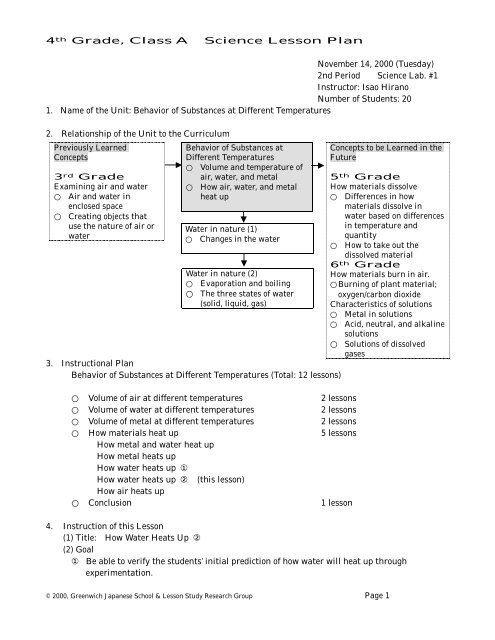
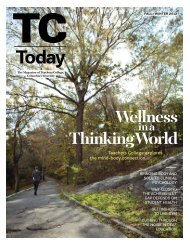

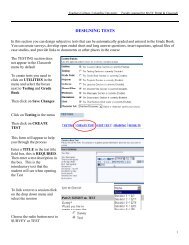
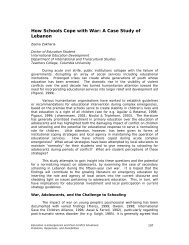






![TC Tod[...].pdf - Teachers College Columbia University](https://img.yumpu.com/27074883/1/190x252/tc-todpdf-teachers-college-columbia-university.jpg?quality=85)

